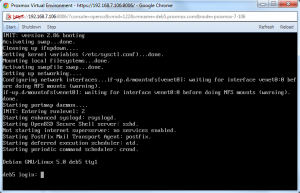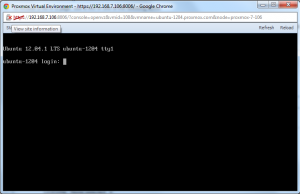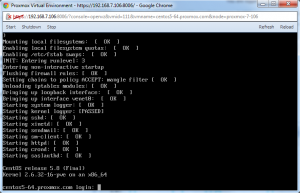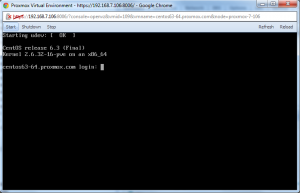OpenVZ Console
Introduction
Beginning with Proxmox VE 2.2, we introduced a new console view (with login capability). Especially for beginners it is not that easy to understand and manage containers but with the new console this is big step forward. OpenVZ and KVM console looks now quite similar.
But as most OpenVZ templates have disabled terminals, you need to enable it first. This article describes for the needed changes for already running OpenVZ container.
Note:
All Debian templates created with latest Debian Appliance Builder got this changes already, just download them vie GUI to your Proxmox VE storage (Debian 6 and 7 templates are up2date, 32 and 64 bit)
Debian
Debian Lenny 5.0
Login via SSH (or use the VNC "Shell") to your Proxmox VE host and 'vzctl enter CTID' the container:
List all running container:
proxmox-ve:~# vzlist
CTID NPROC STATUS IP_ADDR HOSTNAME
108 23 running 192.168.9.20 ubuntu-1204.proxmox.com
109 18 running 192.168.9.21 centos63-64.proxmox.com
111 15 running 192.168.9.23 centos5-64.proxmox.com
114 14 running 192.168.9.30 deb6-32.proxmox.com
115 15 running 192.168.9.31 deb7-32.proxmox.com
122 14 running 192.168.9.36 deb5.proxmox.com
Enter the container:
proxmox-ve:~# vzctl enter 122
root@debian:/# nano /etc/inittab
On the bottom of /etc/inittab just add the following line:
1:2345:respawn:/sbin/getty 38400 tty1
Save the changes and shutdown/start the container via Console.
Debian Squeeze 6.0
Same as Debian Lenny 5.0
Debian Wheezy 7.0
Same as Debian Lenny 5.0
Ubuntu
Ubuntu 12.04
Login via SSH (or use the VNC "Shell") to your Proxmox VE host and 'vzctl enter CTID' the container:
List all running container:
proxmox-ve:~# vzlist
CTID NPROC STATUS IP_ADDR HOSTNAME
108 23 running 192.168.9.20 ubuntu-1204.proxmox.com
109 18 running 192.168.9.21 centos63-64.proxmox.com
111 15 running 192.168.9.23 centos5-64.proxmox.com
114 14 running 192.168.9.30 deb6-32.proxmox.com
115 15 running 192.168.9.31 deb7-32.proxmox.com
122 14 running 192.168.9.36 deb5.proxmox.com
Enter the container:
proxmox-ve:~# vzctl enter 108
root@ubuntu-1204:/# nano /etc/init/tty1.conf
Change/Create the file that it looks exactly like this:
# tty1 - getty # # This service maintains a getty on tty1 from the point the system is # started until it is shut down again. start on stopped rc RUNLEVEL=[2345] stop on runlevel [!2345] respawn exec /sbin/getty -8 38400 tty1
Save the changes and shutdown/start the container via Console.
Centos
Centos 5
Login via SSH (or use the VNC "Shell") to your Proxmox VE host and 'vzctl enter CTID' the container:
List all running container:
proxmox-ve:~# vzlist
CTID NPROC STATUS IP_ADDR HOSTNAME
108 23 running 192.168.9.20 ubuntu-1204.proxmox.com
109 18 running 192.168.9.21 centos63-64.proxmox.com
111 15 running 192.168.9.23 centos5-64.proxmox.com
114 14 running 192.168.9.30 deb6-32.proxmox.com
115 15 running 192.168.9.31 deb7-32.proxmox.com
122 14 running 192.168.9.36 deb5.proxmox.com
Enter the container:
proxmox-ve:~# vzctl enter 111
root@centos5-64:/# nano /etc/inittab
On the bottom of /etc/inittab just add the following line:
1:2345:respawn:/sbin/agetty tty1 38400 linux
Save the changes and shutdown/start the container via Console.
Centos 6
Login via SSH (or use the VNC "Shell") to your Proxmox VE host and 'vzctl enter CTID' the container:
List all running container:
proxmox-ve:~# vzlist
CTID NPROC STATUS IP_ADDR HOSTNAME
108 23 running 192.168.9.20 ubuntu-1204.proxmox.com
109 18 running 192.168.9.21 centos63-64.proxmox.com
111 15 running 192.168.9.23 centos5-64.proxmox.com
114 14 running 192.168.9.30 deb6-32.proxmox.com
115 15 running 192.168.9.31 deb7-32.proxmox.com
122 14 running 192.168.9.36 deb5.proxmox.com
Enter the container:
proxmox-ve:~# vzctl enter 109
root@centos63-64:/# nano /etc/init/tty.conf
Change/Create the file that it looks exactly like this:
# This service maintains a getty on tty1 from the point the system is # started until it is shut down again. start on stopped rc RUNLEVEL=[2345] stop on runlevel [!2345] respawn exec /sbin/agetty -8 tty1 38400
Save the changes and shutdown/start the container via Console.
Troubleshooting
If you still want to use the previous method (vzctl enter CTID) you can open the host "Shell" and just type 'vzctl enter CTID" to manage your containers.



